目录
vector的介绍及使用
vector的介绍
1、vector是表示可变大小数组的序列容器。
2、vector就像数组一样,也采用的连续空间来存储元素,这也意味着可以采用下标对vector的元素进行访问。
3、vector与普通数组不同的是,vector的大小是可以动态改变的。
4、当vector需要重新分配大小时,其做法是,分配一个新的数组,然后将全部元素移到这个数组当中,并释放原来的数组空间。
5、vector分配空间策略:vector会分配一些额外的空间以适应可能的增长,因此存储空间比实际需要的存储空间一般更大。不同的库采用不同的策略权衡空间的使用和重新分配,以至于在末尾插入一个元素的时候是在常数的时间复杂度完成的。
6、由于vector采用连续的空间来存储元素,与其他动态序列容器相比,vector在访问元素的时候更加高效,在其末尾添加和删除元素相对高效,而对于不在其末尾进行的删除和插入操作效率则相对较低。
7、 string与vector< char >类似,string是专门针对字符数组设计的,vector是针对所有类型的数组设计的,因此vector< char >后面没有/0,string后面有。
vector的使用
vector的定义方式

方式一: 构造一个某类型的空容器。
vector<int> v1; //构造int类型的空容器
方式二: 构造一个含有n个val的某类型容器。
vector<int> v2(10, 2); //构造含有10个2的int类型容器
方式三: 拷贝构造某类型容器的复制品。
vector<int> v3(v2); //拷贝构造int类型的v2容器的复制品
方式四: 使用迭代器拷贝构造某一段内容。
vector<int> v4(v2.begin(), v2.end()); //使用迭代器拷贝构造v2容器的某一段内容
注意:该方式也可用于拷贝其他容器的某一段内容。
string s("hello world");
vector<char> v5(s.begin(), s.end()); //拷贝构造string对象的某一段内容
vector iterator 的使用
1.普通遍历容器
void test_vector1()
{
vector<int> v1;
v1.push_back(1);
v1.push_back(2);
v1.push_back(3);
v1.push_back(4);
for (size_t i = 0; i < v1.size(); i++)
{
cout << v1[i] << " ";
}
cout << endl;
}
2.范围for遍历容器
for (auto e : v1)
{
cout << e << " ";
}
cout << endl;
3.迭代器遍历容器:


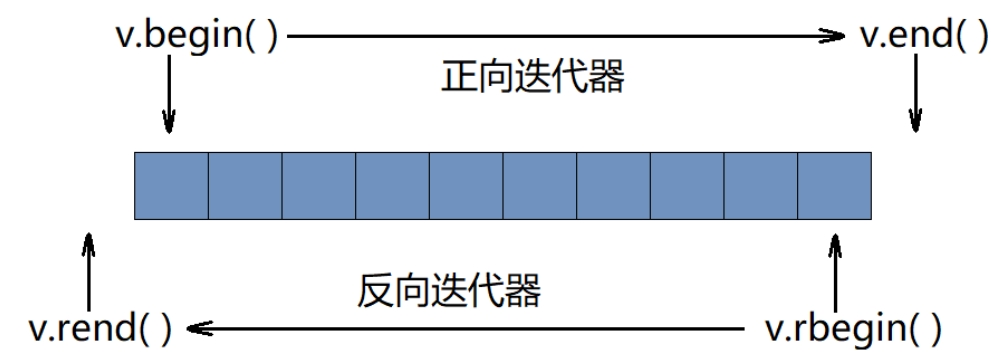
begin和end
通过begin函数可以得到容器中第一个元素的正向迭代器,通过end函数可以得到容器中最后一个元素的后一个位置的正向迭代器。
正向迭代器遍历容器:
#include <iostream>
#include <vector>
using namespace std;
int main()
{
vector<int> v(10, 2);
//正向迭代器遍历容器
vector<int>::iterator it = v.begin();
while (it != v.end())
{
cout << *it << " ";
it++;
}
cout << endl;
return 0;
}
rbegin和rend
通过rbegin函数可以得到容器中最后一个元素的反向迭代器,通过rend函数可以得到容器中第一个元素的前一个位置的反向迭代器。
反向迭代器遍历容器:
#include <iostream>
#include <vector>
using namespace std;
int main()
{
vector<int> v(10, 2);
//反向迭代器遍历容器
vector<int>::reverse_iterator rit = v.rbegin();
while (rit != v.rend())
{
cout << *rit << " ";
rit++;
}
cout << endl;
return 0;
}
vector < string > 存储数据的三种方式
void push_back(const string& s){}
void test_vector2()
{
vector<string> v2;
}
方式一: 使用有名对象
string s1("张三");
v2.push_back(s1);
方式二: 使用匿名对象
v2.push_back(string("李四"));
方式三:
v2.push_back("王五");//string是单参数构造函数,“王五”隐式类型转换成string,产生临时对象,具有常性,因此s可以引用“王五”
vector的空间增长问题
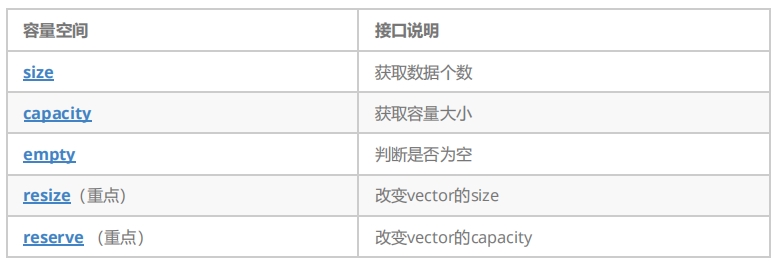
1.size和capacity:
通过size函数获取当前容器中的有效元素个数,通过capacity函数获取当前容器的最大容量。
#include <iostream>
#include <vector>
using namespace std;
int main()
{
vector<int> v(10, 2);
cout << v.size() << endl; //获取当前容器中的有效元素个数
cout << v.capacity() << endl; //获取当前容器的最大容量
return 0;
}
2.empty:
通过empty函数判断当前容器是否为空。
#include <iostream>
#include <vector>
using namespace std;
int main()
{
vector<int> v(10, 2);
cout << v.empty() << endl;
return 0;
}
3.reserve和resize:
通过reserse函数改变容器的最大容量,resize函数改变容器中的有效元素个数。
reserve规则:
1、当所给值大于容器当前的capacity时,将capacity扩大到该值。
2、当所给值小于容器当前的capacity时,什么也不做。
resize规则:
1、当所给值大于容器当前的size时,将size扩大到该值,扩大的元素为第二个所给值,若未给出,则默认为0。
2、当所给值小于容器当前的size时,将size缩小到该值。
#include <iostream>
#include <vector>
using namespace std;
int main()
{
vector<int> v(10, 2);
cout << v.size() << endl; //10
cout << v.capacity() << endl; //10
v.reserve(20); //改变容器的capacity为20,size不变
cout << v.size() << endl; //10
cout << v.capacity() << endl; //20
v.resize(15); //改变容器的size为15
cout << v.size() << endl; //15
cout << v.capacity() << endl; //20
return 0;
}
vector的增删查改
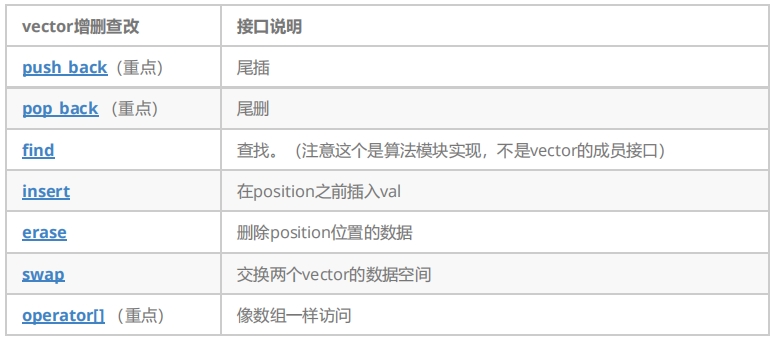
1.push_back和pop_back:
通过push_back函数对容器进行尾插,pop_back函数对容器进行尾删。
#include <iostream>
#include <vector>
using namespace std;
int main()
{
vector<int> v;
v.push_back(1); //尾插元素1
v.push_back(2); //尾插元素2
v.push_back(3); //尾插元素3
v.push_back(4); //尾插元素4
v.pop_back(); //尾删元素
v.pop_back(); //尾删元素
v.pop_back(); //尾删元素
v.pop_back(); //尾删元素
return 0;
}
2.find:
find函数共三个参数,前两个参数确定一个迭代器区间(左闭右开),第三个参数确定所要寻找的值。
find函数在所给迭代器区间寻找第一个匹配的元素,并返回它的迭代器,若未找到,则返回所给的第二个参数。
#include <iostream>
#include <vector>
#include <algorithm>
using namespace std;
int main()
{
vector<int> v;
v.push_back(1);
v.push_back(2);
v.push_back(3);
v.push_back(4);
vector<int>::iterator pos = find(v.begin(), v.end(), 2); //获取值为2的元素的迭代器
v.insert(pos, 10); //在2的位置插入10
pos = find(v.begin(), v.end(), 3); //获取值为3的元素的迭代器
v.erase(pos); //删除3
return 0;
}
3.insert和erase:
通过insert函数可以在所给迭代器位置插入一个或多个元素,通过erase函数可以删除所给迭代器位置的元素,或删除所给迭代器区间内的所有元素(左闭右开)。
#include <iostream>
#include <vector>
using namespace std;
int main()
{
vector<int> v;
v.push_back(1);
v.push_back(2);
v.push_back(3);
v.push_back(4);
v.insert(v.begin(), 0); //在容器开头插入0
v.insert(v.begin(), 5, -1); //在容器开头插入5个-1
v.erase(v.begin()); //删除容器中的第一个元素
v.erase(v.begin(), v.begin() + 5); //删除在该迭代器区间内的元素(左闭右开)
return 0;
}
4.swap:
通过swap函数可以交换两个容器的数据空间,实现两个容器的交换。
#include <iostream>
#include <vector>
using namespace std;
int main()
{
vector<int> v1(10, 1);
vector<int> v2(10, 2);
v1.swap(v2); //交换v1,v2的数据空间
return 0;
}
5.operator[ ] :
vector当中实现了 [ ] 操作符的重载,因此我们也可以通过“下标+[ ]”的方式对容器当中的元素进行访问。
#include <iostream>
#include <vector>
using namespace std;
int main()
{
vector<int> v(10, 1);
//使用“下标+[]”的方式遍历容器
for (size_t i = 0; i < v.size(); i++)
{
cout << v[i] << " ";
}
cout << endl;
return 0;
}
vector迭代器失效问题
迭代器的主要作用就是让算法能够不用关心底层数据结构,其底层实际就是一个指针,或者是对指针进行了
封装,比如:vector的迭代器就是原生态指针T* 。因此迭代器失效,实际就是迭代器底层对应指针所指向的
空间被销毁了,而使用一块已经被释放的空间,造成的后果是程序崩溃(即如果继续使用已经失效的迭代器,
程序可能会崩溃)。
对于vector可能会导致其迭代器失效的操作有:
1. 会引起其底层空间改变的操作,都有可能是迭代器失效,比如:resize、reserve、insert、assign、push_back等
#include <iostream>
using namespace std;
#include <vector>
int main()
{
vector<int> v{1,2,3,4,5,6};
auto it = v.begin();
// 将有效元素个数增加到100个,多出的位置使用8填充,操作期间底层会扩容
// v.resize(100, 8);
// reserve的作用就是改变扩容大小但不改变有效元素个数,操作期间可能会引起底层容量改变
// v.reserve(100);
// 插入元素期间,可能会引起扩容,而导致原空间被释放
// v.insert(v.begin(), 0);
// v.push_back(8);
// 给vector重新赋值,可能会引起底层容量改变
v.assign(100, 8);
出错原因: 以上操作,都有可能会导致vector扩容,也就是说vector底层原理旧空间被释放掉,
而在打印时,it还使用的是释放之间的旧空间,在对it迭代器操作时,实际操作的是一块已经被释放的空间,而引起代码运行时崩溃。
解决方式: 在以上操作完成之后,如果想要继续通过迭代器操作vector中的元素,只需给it重新赋值即可。
while(it != v.end())
{
cout<< *it << " " ;
++it;
}
cout<<endl;
return 0;
}
2.指定位置元素的删除操作–erase
#include <iostream>
using namespace std;
#include <vector>
int main()
{
int a[] = { 1, 2, 3, 4 };
vector<int> v(a, a + sizeof(a) / sizeof(int));
// 使用find查找3所在位置的iterator
vector<int>::iterator pos = find(v.begin(), v.end(), 3);
// 删除pos位置的数据,导致pos迭代器失效。
v.erase(pos);
cout << *pos << endl; // 此处会导致非法访问
return 0;
}
出错原因: erase删除pos位置元素后,pos位置之后的元素会往前搬移,没有导致底层空间的改变,理论上讲迭代器不应该会失效,但是:如果pos刚好是最后一个元素,删完之后pos刚好是end的位置,而end位置是没有元素的,那么pos就失效了。因此删除vector中任意位置上元素时,vs就认为该位置迭代器失效了。
解决方法: 在删除元素之后,对pos迭代器重新赋值,使其指向删除元素后的合法方向
v.erase(pos);
pos = find(v.begin(), v.end(), 3);
cout << *pos << endl;
return 0;
3.删除vector中所有的偶数
#include <iostream>
#include <vector>
using namespace std;
int main()
{
vector<int> v;
for (size_t i = 1; i <= 6; i++)
{
v.push_back(i);
}
vector<int>::iterator it = v.begin();
while (it != v.end())
{
if (*it % 2 == 0) //删除容器当中的全部偶数
{
v.erase(it);
}
it++;
}
return 0;
}
出错原因: 该代码看上去实际上并没有什么错误,但如果你画图仔细分析,你就会发现该代码的问题所在,迭代器访问到了不属于容器的内存空间,导致程序崩溃。
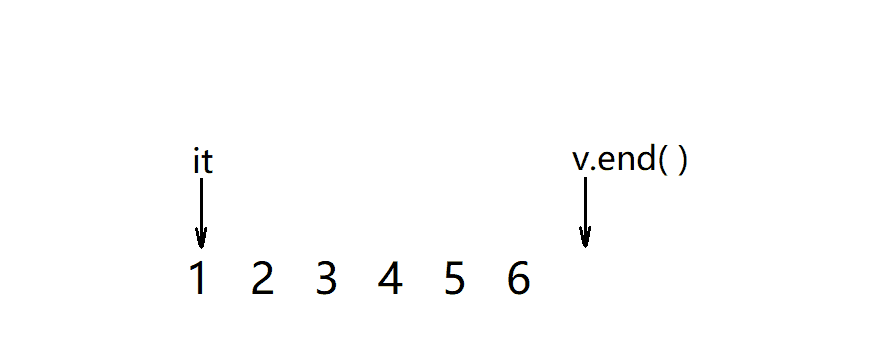
不仅如此,而且在迭代器遍历容器中的元素进行判断时,并没有对1、3、5元素进行判断。
解决方法: 我们可以接收erase函数的返回值(erase函数返回删除元素的后一个元素的新位置),并且控制代码的逻辑:当元素被删除后继续判断该位置的元素(因为该位置的元素已经更新,需要再次判断)。
#include <iostream>
#include <vector>
using namespace std;
int main()
{
vector<int> v;
for (size_t i = 1; i <= 6; i++)
{
v.push_back(i);
}
vector<int>::iterator it = v.begin();
while (it != v.end())
{
if (*it % 2 == 0) //删除容器当中的全部偶数
{
it = v.erase(it); //删除后获取下一个元素的迭代器
}
else
{
it++; //是奇数则it++
}
}
return 0;
}
注意: Linux下,g++编译器对迭代器失效的检测并不是非常严格,处理也没有vs下极端。
// 1. 扩容之后,迭代器已经失效了,程序虽然可以运行,但是运行结果已经不对了
int main()
{
vector<int> v{1,2,3,4,5};
for(size_t i = 0; i < v.size(); ++i)
cout << v[i] << " ";
cout << endl;
auto it = v.begin();
cout << "扩容之前,vector的容量为: " << v.capacity() << endl;
// 通过reserve将底层空间设置为100,目的是为了让vector的迭代器失效
v.reserve(100);
cout << "扩容之后,vector的容量为: " << v.capacity() << endl;
// 经过上述reserve之后,it迭代器肯定会失效,在vs下程序就直接崩溃了,但是linux下不会
// 虽然可能运行,但是输出的结果是不对的
while(it != v.end())
{
cout << *it << " ";
++it;
}
cout << endl;
return 0;
}
程序输出:
1 2 3 4 5
扩容之前,vector的容量为: 5
扩容之后,vector的容量为: 100
0 2 3 4 5 409 1 2 3 4 5
// 2. erase删除任意位置代码后,linux下迭代器并没有失效
// 因为空间还是原来的空间,后序元素往前搬移了,it的位置还是有效的
#include <vector>
#include <algorithm>
int main()
{
vector<int> v{1,2,3,4,5};
vector<int>::iterator it = find(v.begin(), v.end(), 3);
v.erase(it);
cout << *it << endl;
while(it != v.end())
{
cout << *it << " ";
++it;
}
cout << endl;
return 0;
}
程序可以正常运行,并打印:
4
4 5
// 3: erase删除的迭代器如果是最后一个元素,删除之后it已经超过end
// 此时迭代器是无效的,++it导致程序崩溃
int main()
{
vector<int> v{1,2,3,4,5};
// vector<int> v{1,2,3,4,5,6};
auto it = v.begin();
while(it != v.end())
{
if(*it % 2 == 0)
v.erase(it);
++it;
}
for(auto e : v)
cout << e << " ";
cout << endl;
return 0;
}
========================================================
// 使用第一组数据时,程序可以运行
[sly@VM-0-3-centos 20220114]$ g++ testVector.cpp -std=c++11
[sly@VM-0-3-centos 20220114]$ ./a.out
1 3 5
=========================================================
// 使用第二组数据时,程序最终会崩溃
[sly@VM-0-3-centos 20220114]$ vim testVector.cpp
[sly@VM-0-3-centos 20220114]$ g++ testVector.cpp -std=c++11
[sly@VM-0-3-centos 20220114]$ ./a.out
Segmentation fault
从上述例子中可以看到:SGI STL中,迭代器失效后,代码并不一定会崩溃,但是运行结果肯定不对,如果it不在begin和end范围内,肯定会崩溃的。
4. 与vector类似,string在插入+扩容操作+erase之后,迭代器也会失效
#include <string>
void TestString()
{
string s("hello");
auto it = s.begin();
// 放开之后代码会崩溃,因为resize到20会string会进行扩容
// 扩容之后,it指向之前旧空间已经被释放了,该迭代器就失效了
// 后序打印时,再访问it指向的空间程序就会崩溃
//s.resize(20, '!');
while (it != s.end())
{
cout << *it;
++it;
}
cout << endl;
it = s.begin();
while (it != s.end())
{
it = s.erase(it);
// 按照下面方式写,运行时程序会崩溃,因为erase(it)之后
// it位置的迭代器就失效了
// s.erase(it);
++it;
}
}
迭代器失效解决办法:在使用前,对迭代器重新赋值即可。
vector 在OJ中的使用。
1.只出现一次的数字i
给你一个 非空 整数数组 nums ,除了某个元素只出现一次以外,其余每个元素均出现两次。找出那个只出现了一次的元素。你必须设计并实现线性时间复杂度的算法来解决此问题,且该算法只使用常量额外空间。
示例 1 :
输入: nums = [2,2,1]
输出: 1
示例 2 :
输入: nums = [4,1,2,1,2]
输出: 4
示例 3 :
输入: nums = [1]
输出: 1
提示:
1 <= nums.length <= 3 * 104
-3 * 104 <= nums[i] <= 3 * 104
除了某个元素只出现一次以外,其余每个元素均出现两次。
class Solution {
public:
int singleNumber(vector<int>& nums) {
int value = 0;
for(auto e : nums)
{value ^= e; }
return value;
}
};
2.杨辉三角
给定一个非负整数 numRows,生成「杨辉三角」的前 numRows 行。在「杨辉三角」中,每个数是它左上方和右上方的数的和。

示例 1:
输入: numRows = 5
输出: [[1],[1,1],[1,2,1],[1,3,3,1],[1,4,6,4,1]]
示例 2:
输入: numRows = 1
输出: [[1]]
提示:
1 <= numRows <= 30
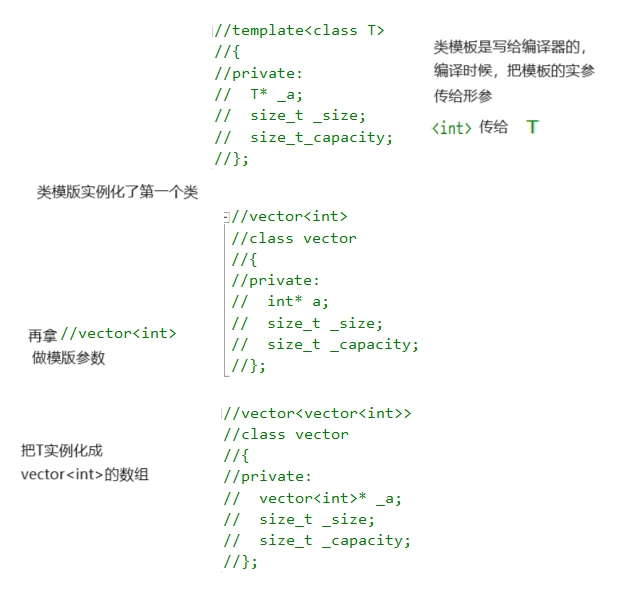
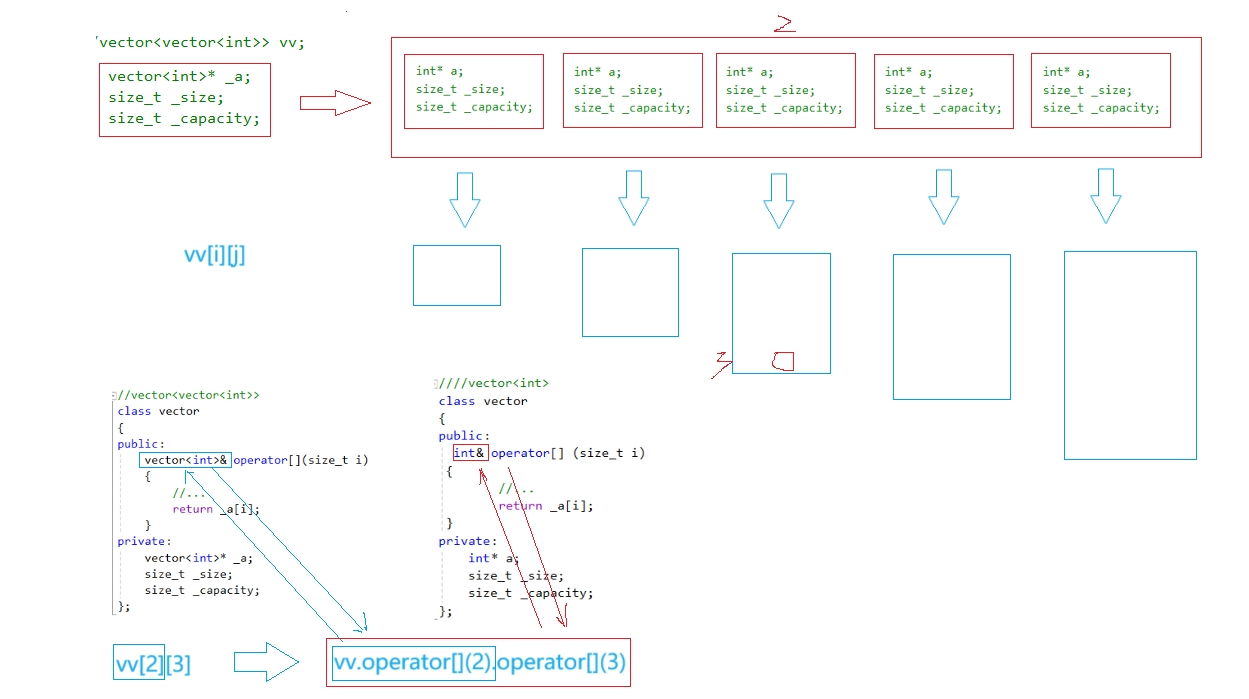
class Solution {
public:
vector<vector<int>> generate(int numRows) {
vector<vector<int>> vv;
vv.resize(numRows);
for(size_t i = 0; i < numRows; ++i)
{
vv[i].resize(i+1,0);
//每一行的一个和最后一个初始化为1
vv[i][0] = vv[i][vv[i].size()-1] = 1;
}
for(size_t i = 0; i < vv.size(); ++i)
{
for(size_t j = 0; j < vv[i].size(); ++j)
{
if(vv[i][j] == 0)
{
vv[i][j] = vv[i-1][j] + vv[i-1][j-1];
}
}
}
return vv;
}
};






















 264
264

 被折叠的 条评论
为什么被折叠?
被折叠的 条评论
为什么被折叠?








